Themed collection Biological optical imaging

Molecular imaging probes for multi-spectral optoacoustic tomography
In this review, we discuss recent progress in emerging optoacoustic probes, their mechanisms, applications and challenges for biological imaging using MSOT.
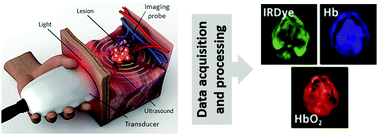
Chem. Commun., 2017,53, 4653-4672
https://doi.org/10.1039/C6CC09421J
Imaging and therapeutic applications of zinc(II)-dipicolylamine molecular probes for anionic biomembranes
Synthetic ZnDPA receptors are used for molecular imaging of disease and targeted therapeutics.
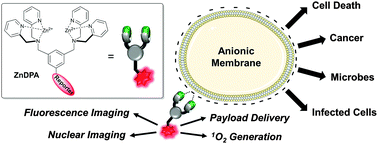
Chem. Commun., 2016,52, 8787-8801
https://doi.org/10.1039/C6CC03669D
SypHer3s: a genetically encoded fluorescent ratiometric probe with enhanced brightness and an improved dynamic range
We designed a genetically encoded ratiometric fluorescent probe, SypHer3s, with enhanced brightness and optimized pKa, which responds to pH changes in different cellular compartments.
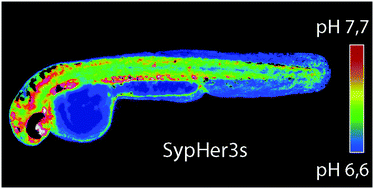
Chem. Commun., 2018,54, 2898-2901
https://doi.org/10.1039/C7CC08740C
Lanthanide-based peptide biosensor to monitor CDK4/cyclin D kinase activity
We describe a lanthanide biosensor that responds to CDK4 kinase activity in melanoma cell extracts through a significant and dose dependent increase in luminescence, thanks to sensitization of a DOTA[Tb3+] complex incorporated into a CDK4 substrate peptide by a unique tryptophan residue in an adjacent phosphoaminoacid binding moiety.

Chem. Commun., 2017,53, 6109-6112
https://doi.org/10.1039/C6CC09948C
A lysosome targetable fluorescent probe for endogenous imaging of hydrogen peroxide in living cells
A lysosome targetable naphthalimide based fluorescent probe has been designed and synthesized for selective imaging of H2O2 in different cells, tissues and in vivo models.
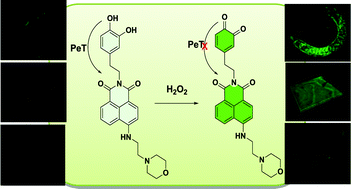
Chem. Commun., 2017,53, 3701-3704
https://doi.org/10.1039/C6CC09127J
Enzyme-responsive reporter molecules for selective localization and fluorescence imaging of pathogenic biofilms
A novel enzyme-responsive reporter molecule (ERM-1) for selective localization of AmpC in pathogenic biofilms.

Chem. Commun., 2017,53, 3330-3333
https://doi.org/10.1039/C6CC09296A
Nucleic acid detection using BRET-beacons based on bioluminescent protein–DNA hybrids
Bioluminescent molecular beacons have been developed using a modular design approach that relies on BRET between the bright luciferase NanoLuc and a Cy3 acceptor.
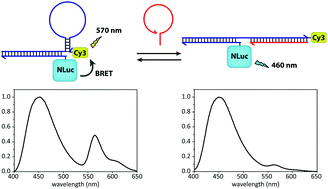
Chem. Commun., 2017,53, 2862-2865
https://doi.org/10.1039/C6CC10032E
Measuring macromolecular crowding in cells through fluorescence anisotropy imaging with an AIE fluorogen
We report a new strategy that allows spatiotemporal visualization of the macromolecular crowding effect in cells.
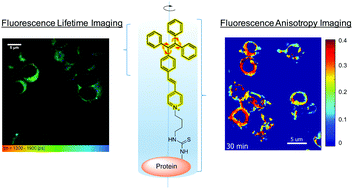
Chem. Commun., 2017,53, 2874-2877
https://doi.org/10.1039/C6CC09916E
moxDendra2: an inert photoswitchable protein for oxidizing environments
The authors describe the engineering of the first monomeric photoswitchable fluorescent protein for use in oxidizing cellular enviornments.
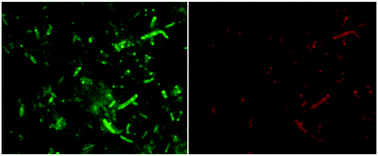
Chem. Commun., 2017,53, 2106-2109
https://doi.org/10.1039/C6CC09997A
Affibody-targeted fluorogen activating protein for in vivo tumor imaging
Compact molecular imaging reagents made of affibody-fused fluorogen activating proteins enable high-contrast imaging or pre-targeting and rapid fluorescent detection.
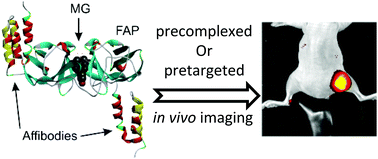
Chem. Commun., 2017,53, 2001-2004
https://doi.org/10.1039/C6CC09137G
PSMA-targeted contrast agents for intraoperative imaging of prostate cancer,
Net charges, spacer length, hydrophobicity, and polarity effects on PSMA-targeted NIR fluorophores.
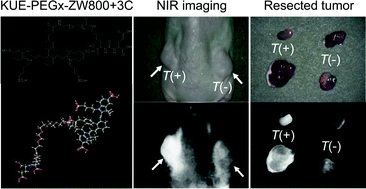
Chem. Commun., 2017,53, 1611-1614
https://doi.org/10.1039/C6CC09781B
A bioorthogonal ‘turn-on’ fluorescent probe for tracking mitochondrial nitroxyl formation
A bioorthogonal mitochondria targeted HNO sensor was applied for the detection of biological concentrations of HNO in vitro in organelles.
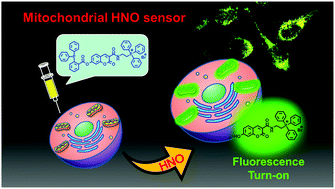
Chem. Commun., 2017,53, 1723-1726
https://doi.org/10.1039/C6CC09082F
Development of a BODIPY-based fluorescent probe for imaging pathological tau aggregates in live cells
As a cell-permeable imaging probe, BD-tau selectively labeled pathological tau aggregates in live neuronal cells.
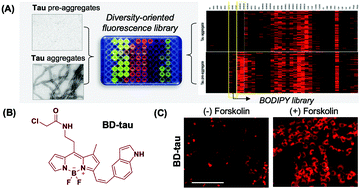
Chem. Commun., 2017,53, 1607-1610
https://doi.org/10.1039/C6CC08826K
Targeted combinational therapy inducing mitochondrial dysfunction
Mitochondria-directed GSH-activated release of a chlorambucil derivative and an AIE dye induces significantly increased mitochondrial dysfunction and apoptosis.
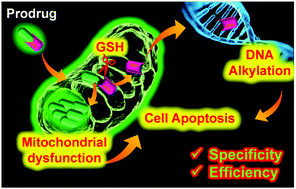
Chem. Commun., 2017,53, 1281-1284
https://doi.org/10.1039/C6CC08977A
A far-red emitting fluorescent marker protein, mGarnet2, for microscopy and STED nanoscopy
We report an advanced monomeric far-red fluorescent marker protein, mGarnet2, which shows excellent performance as a live-cell fusion marker for microscopy as well as STED nanoscopy with 640 nm excitation and 780 nm depletion wavelengths.
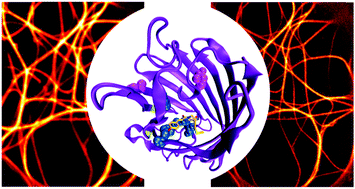
Chem. Commun., 2017,53, 979-982
https://doi.org/10.1039/C6CC09081H
Intrinsic blinking of red fluorescent proteins for super-resolution microscopy
Blinking of some RFPs in live untreated cells can be used to reconstruct super-resolved images.
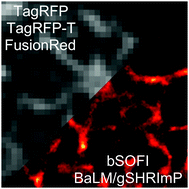
Chem. Commun., 2017,53, 949-951
https://doi.org/10.1039/C6CC09200D
A Trp-BODIPY cyclic peptide for fluorescence labelling of apoptotic bodies
We describe the synthesis and characterization of a Trp-BODIPY fluorogenic peptide for labelling subcellular bodies released by human apoptotic cells.
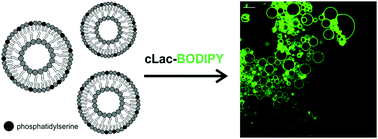
Chem. Commun., 2017,53, 945-948
https://doi.org/10.1039/C6CC07879F
An efficient two-photon fluorescent probe for human NAD(P)H:quinone oxidoreductase (hNQO1) detection and imaging in tumor cells
The probe TPQ, which displays high selectivity and anti-interference ability, was successfully applied to endogenous hNQO1 imaging and for the identification of different cancer cells.
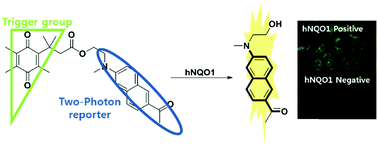
Chem. Commun., 2017,53, 525-528
https://doi.org/10.1039/C6CC08971B
Headgroup engineering in mechanosensitive membrane probes
Tricky chemistry had to be addressed to make mechanosensitive membrane probes ready for use, including a chalcogen-bond mediated “molecular guillotinylation”.
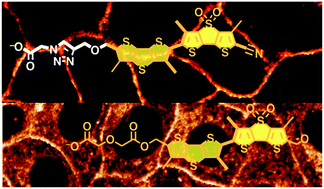
Chem. Commun., 2016,52, 14450-14453
https://doi.org/10.1039/C6CC08771J
Ratiometric and photoconvertible fluorescent protein-based voltage indicator prototypes
We have explored the potential utility of several new designs for genetically encoded indicators of membrane potential.
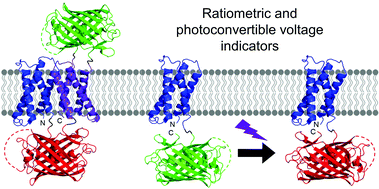
Chem. Commun., 2016,52, 14153-14156
https://doi.org/10.1039/C6CC06810C
Real-time monitoring of vesicle pH in an endocytic pathway using an EGF-conjugated two-photon probe
An EGF-conjugated two-photon probe for real-time monitoring and quantitative analysis of luminal pH values during endocytic pathway activity was reported.
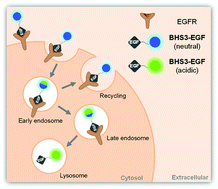
Chem. Commun., 2016,52, 14007-14010
https://doi.org/10.1039/C6CC08036G
Green-to-red primed conversion of Dendra2 using blue and red lasers
Primed photoconversion of Dendra2 in commonly available confocal and super-resolution microscopy setups equipped with blue and red lasers is described.
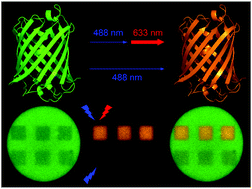
Chem. Commun., 2016,52, 13144-13146
https://doi.org/10.1039/C6CC05599K
About this collection
This web themed collection, guest edited by Robert Campbell (University of Alberta), Carsten Schultz (EMBL) and Young-Tae Chang (National University of Singapore), is a celebration of current achievements and future perspectives in the field of Biological Optical Imaging. The last decade has seen tremendous advances in methods for optical imaging and sensing in live cells. These practical advances have come as a combination of sudden leaps forward and steady development of improved versions of existing tools. This web themed collection aims to provide a sampling of the full landscape of biological optical imaging research, ranging from fundamental photophysical studies, to methodology and techniques (both molecular and instrumental), to biological applications of optical imaging.